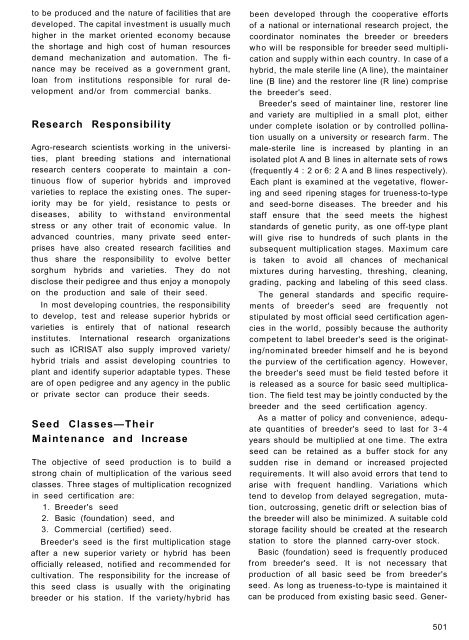RA 00048.pdf - OAR@ICRISAT
RA 00048.pdf - OAR@ICRISAT
RA 00048.pdf - OAR@ICRISAT
Create successful ePaper yourself
Turn your PDF publications into a flip-book with our unique Google optimized e-Paper software.
to be produced and the nature of facilities that are<br />
developed. The capital investment is usually much<br />
higher in the market oriented economy because<br />
the shortage and high cost of human resources<br />
demand mechanization and automation. The finance<br />
may be received as a government grant,<br />
loan from institutions responsible for rural development<br />
and/or from commercial banks.<br />
Research Responsibility<br />
Agro-research scientists working in the universities,<br />
plant breeding stations and international<br />
research centers cooperate to maintain a continuous<br />
flow of superior hybrids and improved<br />
varieties to replace the existing ones. The superiority<br />
may be for yield, resistance to pests or<br />
diseases, ability to withstand environmental<br />
stress or any other trait of economic value. In<br />
advanced countries, many private seed enterprises<br />
have also created research facilities and<br />
thus share the responsibility to evolve better<br />
sorghum hybrids and varieties. They do not<br />
disclose their pedigree and thus enjoy a monopoly<br />
on the production and sale of their seed.<br />
In most developing countries, the responsibility<br />
to develop, test and release superior hybrids or<br />
varieties is entirely that of national research<br />
institutes. International research organizations<br />
such as ICRISAT also supply improved variety/<br />
hybrid trials and assist developing countries to<br />
plant and identify superior adaptable types. These<br />
are of open pedigree and any agency in the public<br />
or private sector can produce their seeds.<br />
Seed Classes—Their<br />
Maintenance and Increase<br />
The objective of seed production is to build a<br />
strong chain of multiplication of the various seed<br />
classes. Three stages of multiplication recognized<br />
in seed certification are:<br />
1. Breeder's seed<br />
2. Basic (foundation) seed, and<br />
3. Commercial (certified) seed.<br />
Breeder's seed is the first multiplication stage<br />
after a new superior variety or hybrid has been<br />
officially released, notified and recommended for<br />
cultivation. The responsibility for the increase of<br />
this seed class is usually with the originating<br />
breeder or his station. If the variety/hybrid has<br />
been developed through the cooperative efforts<br />
of a national or international research project, the<br />
coordinator nominates the breeder or breeders<br />
who will be responsible for breeder seed multiplication<br />
and supply within each country. In case of a<br />
hybrid, the male sterile line (A line), the maintainer<br />
line (B line) and the restorer line (R line) comprise<br />
the breeder's seed.<br />
Breeder's seed of maintainer line, restorer line<br />
and variety are multiplied in a small plot, either<br />
under complete isolation or by controlled pollination<br />
usually on a university or research farm. The<br />
male-sterile line is increased by planting in an<br />
isolated plot A and B lines in alternate sets of rows<br />
(frequently 4 : 2 or 6: 2 A and B lines respectively).<br />
Each plant is examined at the vegetative, flowering<br />
and seed ripening stages for trueness-to-type<br />
and seed-borne diseases. The breeder and his<br />
staff ensure that the seed meets the highest<br />
standards of genetic purity, as one off-type plant<br />
will give rise to hundreds of such plants in the<br />
subsequent multiplication stages. Maximum care<br />
is taken to avoid all chances of mechanical<br />
mixtures during harvesting, threshing, cleaning,<br />
grading, packing and labeling of this seed class.<br />
The general standards and specific requirements<br />
of breeder's seed are frequently not<br />
stipulated by most official seed certification agencies<br />
in the world, possibly because the authority<br />
competent to label breeder's seed is the originating/nominated<br />
breeder himself and he is beyond<br />
the purview of the certification agency. However,<br />
the breeder's seed must be field tested before it<br />
is released as a source for basic seed multiplication.<br />
The field test may be jointly conducted by the<br />
breeder and the seed certification agency.<br />
As a matter of policy and convenience, adequate<br />
quantities of breeder's seed to last for 3 - 4<br />
years should be multiplied at one time. The extra<br />
seed can be retained as a buffer stock for any<br />
sudden rise in demand or increased projected<br />
requirements. It will also avoid errors that tend to<br />
arise with frequent handling. Variations which<br />
tend to develop from delayed segregation, mutation,<br />
outcrossing, genetic drift or selection bias of<br />
the breeder will also be minimized. A suitable cold<br />
storage facility should be created at the research<br />
station to store the planned carry-over stock.<br />
Basic (foundation) seed is frequently produced<br />
from breeder's seed. It is not necessary that<br />
production of all basic seed be from breeder's<br />
seed. As long as trueness-to-type is maintained it<br />
can be produced from existing basic seed. Gener-<br />
501

















